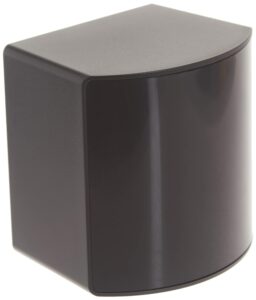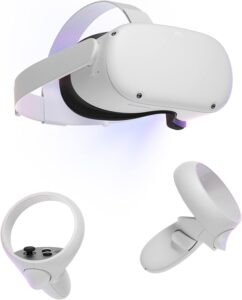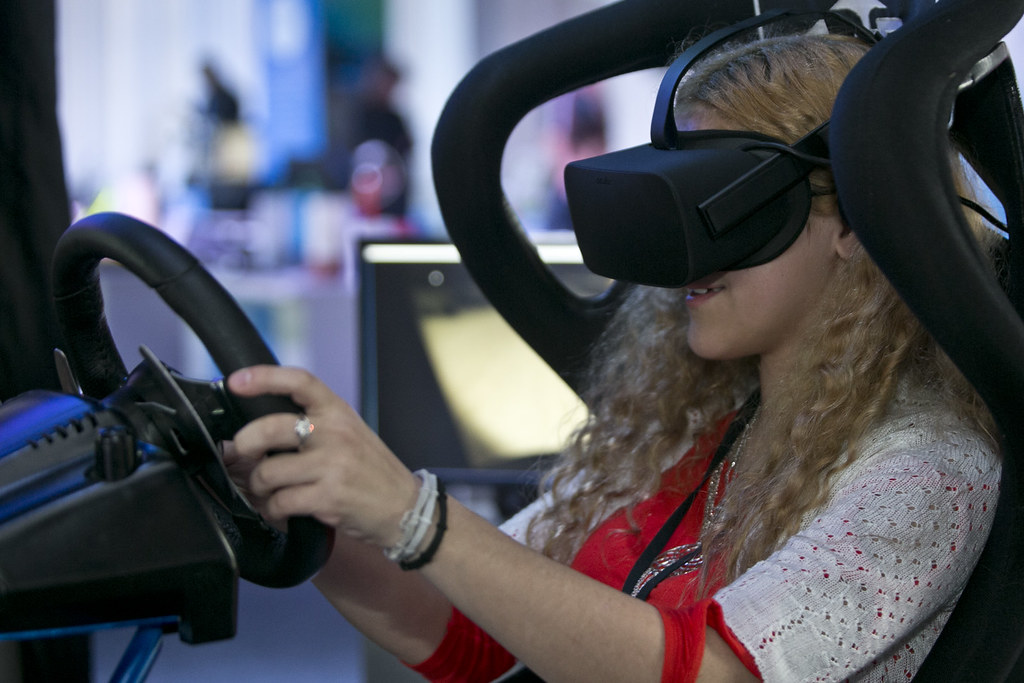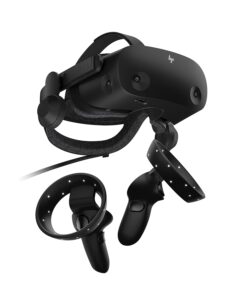Subscribe now for hand-picked best experiences, product discounts, and the latest VR trends, tips and tricks, straight to your inbox.
Sim racing is one of the most immersive and realistic ways to enjoy your favorite racing games. Whether you want to feel the thrill of driving a Formula 1 car, a rally car, or a supercar, when paired with accessories like a racing wheel and pedal set, sim racing can give you the sensation of being behind the wheel and on the track.
But to get the most out of your sim racing experience, you need a good VR headset. VR headsets can make you feel like you are actually in the cockpit of your car, with a 360-degree view of your surroundings and a high level of detail and clarity. VR headsets can also enhance your sense of speed, depth, and motion, making you more immersed and engaged in your racing.
However, not all VR headsets are created equal. Some are better suited for sim racing than others, depending on their features, performance, and compatibility. In this article, we will review the 3 best VR headsets for sim racing in 2024, based on their resolution, refresh rate, field of view, comfort, audio quality, tracking system, and price. We will also give you some tips on how to choose the right VR headset for your sim racing needs and preferences.
Amazon Affiliate Disclaimer:
This website is a participant in the Amazon Services LLC Associates Program, an affiliate advertising program designed to provide a means for sites to earn advertising fees by advertising and linking to Amazon.com. As an Amazon Associate, we earn from qualifying purchases. We get commissions for purchases made through links in this website. Amazon and the Amazon logo are trademarks of Amazon.com, Inc., or its affiliates.
Key Takeaways:
| VR Headset | Resolution | Refresh Rate | Field of View | Price |
|---|---|---|---|---|
| Pimax Crystal | 2880 x 2880 per eye | 72 to 160 Hz | Up to 140 degrees | $1599 |
| HP Reverb G2 | 2160 x 2160 per eye | 90 Hz | 114 degrees | $599 |
| Meta Quest 2 | 1832 x 1920 per eye | 72 to 120 Hz | 98 degrees | $249 |
- The Pimax Crystal is the best VR headset for sim racing if you want the highest resolution, refresh rate, and field of view of all headsets on this list. It offers a stunning visual quality and a wide peripheral vision that can make you feel like you are in a real car. However, it is also the most expensive and demanding VR headset on the market, requiring a powerful PC if you want the best graphics.
- The HP Reverb G2 is the best VR headset for sim racing if you want a balanced combination of resolution, refresh rate, and field of view. It offers a sharp and clear image quality and a decent peripheral vision that can enhance your immersion and realism. It is also more affordable and easier to set up than the Pimax Crystal, as it uses inside-out tracking and does not need a base station.
- The Meta Quest 2 is the best VR headset for sim racing if you want a budget-friendly and versatile option. It offers a good resolution and refresh rate and a satisfactory field of view that can provide you with a smooth and enjoyable sim racing experience. It is also the only standalone VR headset on this list, meaning that although you can hook it up to a PC using the optional link cable, it does not need a PC or a base station to run. However, it also has some limitations, such as lower battery life, less comfort, and less compatibility with some sim racing games.
What to Look for in a VR Headset for Sim Racing
Before we dive into the details of each VR headset, let’s first go over some of the main factors that you should consider when choosing a VR headset for sim racing.
Resolution
Resolution is one of the most important aspects of VR headsets, as it determines how sharp and detailed the images are. Higher resolution means higher pixel density, which means less screen door effect (the visible gaps between pixels) and more realism.
For sim racing, resolution is especially important because it affects how well you can see the track, the cars, the gauges, and the menus. Higher resolution can also help you spot potential hazards, such as other cars or obstacles.
The resolution of VR headsets is usually measured in pixels per eye (PPE), which is the number of pixels that each eye can see. The higher the PPE, the better the resolution.
However, resolution is not everything. Higher resolution also means higher computational load for your PC or your VR headset. This means that you need a more powerful hardware to run higher-resolution VR headsets smoothly and without lag or stuttering.
Therefore, when choosing a VR headset for sim racing, you need to balance resolution with performance. You need to find a VR headset that has a high enough resolution to satisfy your visual standards but also compatible with your PC or your VR headset’s specifications.
Refresh Rate
Refresh rate is another important aspect of VR headsets, as it determines how smooth and fluid the images are. Higher refresh rate means higher frame rate (the number of times an image is updated per second), which means less motion blur and more responsiveness.
For sim racing, refresh rate is especially important because it affects how well you can perceive speed, depth, and motion. Higher refresh rate can also help you avoid motion sickness (the feeling of nausea or discomfort caused by the mismatch between what you see and what you feel).
The refresh rate of VR headsets is usually measured in hertz (Hz), which is the number of times an image is updated per second. The higher the Hz, the better the refresh rate.
However, refresh rate is also not everything. Higher refresh rate also means higher computational load for your PC or your VR headset. This means that you need a more powerful hardware to run higher-refresh-rate VR headsets smoothly and without lag or stuttering.
Therefore, when choosing a VR headset for sim racing, you need to balance refresh rate with performance. You need to find a VR headset that has a high enough refresh rate to satisfy your motion standards but also compatible with your PC or your VR headset’s specifications.
Field of View
Field of view is another important aspect of VR headsets, as it determines how wide and immersive the images are. Higher field of view means higher angle of view (the amount of the scene that you can see at once), which means more peripheral vision and more immersion.
For sim racing, field of view is especially important because it affects how well you can see the track, the cars, and the environment. Higher field of view can also help you feel more present and engaged in your racing.
The field of view of VR headsets is usually measured in degrees (°), which is the angle of view that you can see at once. The higher the °, the better the field of view.
However, field of view is also not everything. Higher field of view also means higher distortion and warping (the bending or stretching of the images at the edges), which can reduce clarity and realism.
Therefore, when choosing a VR headset for sim racing, you need to balance field of view with quality. You need to find a VR headset that has a high enough field of view to satisfy your immersion standards but also maintains a good image quality and does not distort or warp too much.
Comfort
Comfort is another important aspect of VR headsets, as it determines how well you can wear and use them for long periods of time. Comfort depends on several factors, such as weight, size, shape, fit, padding, straps, ventilation, and adjustability.
For sim racing, comfort is especially important because it affects how well you can enjoy and endure your racing sessions. Comfort can also affect your performance and concentration, as discomfort can distract you and cause fatigue.
The comfort of VR headsets is usually subjective and personal, as different people have different preferences and needs. However, some general guidelines are:
- Choose a VR headset that is light enough to not strain your neck or head.
- Choose a VR headset that is small enough to not obstruct your vision or movement.
- Choose a VR headset that is shaped to fit your face and head comfortably.
- Choose a VR headset that has enough padding to cushion your face and ears.
- Choose a VR headset that has adjustable straps to secure it firmly and evenly.
- Choose a VR headset that has enough ventilation to prevent overheating or sweating.
- Choose a VR headset that has adjustable lenses or IPD (interpupillary distance) to match your eyesight and eye distance.
Audio Quality
Audio quality is another important aspect of VR headsets, as it determines how well you can hear and communicate in your racing games. Audio quality depends on several factors, such as speakers, headphones, microphones, volume, soundstage, bass, treble, and noise cancellation.
For sim racing, audio quality is especially important because it affects how well you can hear the engine sounds, the tire sounds, the wind sounds, and the voice chat. Audio quality can also affect your immersion and realism, as sound can create atmosphere and mood.
The audio quality of VR headsets is usually objective and measurable, as different audio devices have different specifications and features. However, some general guidelines are:
- Choose a VR headset that has built-in speakers or headphones that deliver clear and loud sound.
- Choose a VR headset that has built-in microphones that capture clear and loud voice.
- Choose a VR headset that has volume controls that allow you to adjust the sound level easily.
- Choose a VR headset that has soundstage (the sense of space and direction in sound) that matches your game environment.
- Choose a VR headset that has bass (the low-frequency sounds) that enhances the engine sounds and the tire sounds.
- Choose a VR headset that has treble (the high-frequency sounds) that enhances the wind sounds and the voice chat.
- Choose a VR headset that has noise cancellation (the reduction of background noise) that blocks out unwanted sounds.
Tracking System

Tracking system is another important aspect of VR headsets, as it determines how well they can track your head movements and position in space. Tracking system depends on several factors, such as sensors, cameras, base stations, controllers, wires, batteries, and compatibility.
For sim racing, tracking system is especially important because it affects how well you can control your car and interact with your game.
Tracking system can also affect your immersion and realism, as tracking can create a sense of presence and movement in your game.
The tracking system of VR headsets is usually classified into two types: outside-in and inside-out. Outside-in tracking uses external devices, such as base stations or cameras, to track your VR headset and controllers. Inside-out tracking uses internal devices, such as cameras or sensors, to track your VR headset and controllers.
For sim racing, outside-in tracking is usually more accurate and reliable than inside-out tracking, as it can track your head movements and position more precisely and consistently. However, outside-in tracking is also more expensive and complicated than inside-out tracking, as it requires additional hardware and setup.
Therefore, when choosing a VR headset for sim racing, you need to balance tracking system with convenience. You need to find a VR headset that has a good enough tracking system to satisfy your control standards but also easy enough to use and maintain.
Price
Price is another important aspect of VR headsets, as it determines how much you are willing and able to spend on your sim racing hobby. Price depends on several factors, such as brand, model, features, performance, quality, and availability.
For sim racing, price is especially important because it affects how much value you can get from your VR headset. Price can also affect your satisfaction and enjoyment, as price can create expectations and comparisons.
However, price is also not everything. Higher price does not always mean higher quality or performance. Sometimes, higher price can also mean higher risk or lower availability.
Therefore, when choosing a VR headset for sim racing, you need to balance price with value. You need to find a VR headset that has a reasonable price that matches your budget and your needs.
The 3 Best VR Headsets for Sim Racing in 2024
Now that we have covered the main factors that you should consider when choosing a VR headset for sim racing, let’s take a look at the 3 best VR headsets for sim racing. We will compare them based on their resolution, refresh rate, field of view, comfort, audio quality, tracking system, and price. We will also give you some pros and cons of each VR headset and some recommendations on who should buy them.
Pimax Crystal
The Pimax Crystal is the best VR headset for sim racing if you want the highest resolution, refresh rate, and field of view possible. It offers a stunning visual quality and a wide peripheral vision that can make you feel like you are in a real car
The Pimax Crystal has a resolution of 2880 x 2880 per eye (PPE), which is the highest among all VR headsets mentioned in this article. It also has a refresh rate of up to 160 Hz (depending on the mode), which is the highest among all VR headsets on the market. It also has a field of view of up to 140 degrees (depending on the mode), which is the widest among all VR headsets on the market.
The Pimax Crystal can either be used in standalone mode (no need for external trackers, or wired to a PC) or can be used with the SteamVR lighthouse tracking system after purchasing the optional faceplate.
The Pimax Crystal also has a decent comfort and audio quality. It has a modular design that allows you to customize it with different face cushions, straps, headphones, and accessories. It also has built-in speakers that deliver clear and loud sound.
However, the Pimax Crystal also has some drawbacks. It is the most expensive VR headset on this list, costing $1699 for the headset only (without controllers or other accessories). It is also the most demanding VR headset on this list, requiring a powerful PC (with at least an RTX 2080 graphics card, Recommended an RTX 3080), It is also not very user-friendly or compatible with some sim racing games (such as Assetto Corsa Competizione or iRacing), requiring some tweaking and adjusting to work properly.
Pros:
- Highest resolution among all VR headsets on this list
- Highest refresh rate among all VR headsets on this list
- Widest field of view among all VR headsets on this list
- Decent comfort and audio quality
- Modular design
- Can be Standalone or used with SteamVR base stations, with the addition of optional faceplate.
Cons:
- Most expensive VR headset on this list
- Most demanding VR headset on this list
- Not very user-friendly or compatible with some sim racing games
Recommendation:
- Buy the Pimax Crystal if you have a high-end PC and you want the best visual quality and immersion possible for your sim racing.
HP Reverb G2
The HP Reverb G2 is the best VR headset for sim racing if you want a balanced combination of resolution, refresh rate, and field of view. It offers a sharp and clear image quality and a decent peripheral vision that can enhance your immersion and realism.
The HP Reverb G2 has a resolution of 2160 x 2160 per eye (PPE), which is the second highest among all VR headsets on the market. It also has a refresh rate of 90 Hz, which is the standard among most VR headsets on the market. It also has a field of view of 114 degrees, which is the average among most VR headsets on the market.
The HP Reverb G2 also has a good comfort and audio quality. It has a lightweight and ergonomic design that fits comfortably on your face and head. It also has built-in headphones, which are the same as the ones found on the Valve Index, which is considered the best on the market, that deliver clear and loud sound with spatial audio (the sense of direction and distance in sound).
However, the HP Reverb G2 also has some drawbacks. It is the second most expensive VR headset on this list, costing $599 for the headset and controllers (without base stations). It is also not very compatible with some sim racing games (such as Assetto Corsa Competizione or iRacing), requiring some tweaking and adjusting to work properly. It also uses inside-out tracking, which is less accurate and reliable than outside-in tracking, especially in low-light or reflective environments.
Pros:
- Second highest resolution among all VR headsets
- Standard refresh rate among most VR headsets
- Average field of view among most VR headsets
- Good comfort and audio quality
- Lightweight and ergonomic design
Cons:
- Second most expensive VR headset on this list
- Not very compatible with some sim racing games
- Less accurate and reliable tracking system
Recommendation:
- Buy the HP Reverb G2 if you have a mid-range PC and you want a good visual quality and immersion for your sim racing.
Meta Quest 2

The Meta Quest 2 is the best VR headset for sim racing if you want a budget-friendly and versatile option. It offers a good resolution and refresh rate and a satisfactory field of view that can provide you with a smooth and enjoyable sim racing experience.
The Meta Quest 2 has a resolution of 1832 x 1920 per eye (PPE), which is the third highest among all VR headsets on the market. It also has a refresh rate of up to 120 Hz (depending on the mode), which is the second highest among all VR headsets on the market. It also has a field of view of 100 degrees, which is the lowest among all VR headsets on this list.
The Meta Quest 2 also has a decent comfort and OK-ish audio quality. It has a simple and sleek design that fits snugly on your face and head. It also has built-in speakers that deliver clear sound with spatial audio, albeit not the best sound, Its what would be considered bare minimum. We recommend pairing it with a good pair of headphones.
The Meta Quest 2, the sole standalone VR headset in this lineup, offers portability and convenience without the need for a PC or base station. However, it comes with drawbacks like limited battery life (2 to 3 hours), and compatibility issues with some sim racing games, necessitating a PC link cable or wireless streaming app for optimal functionality.
Pros:
- Third highest resolution among all VR headsets
- Second highest refresh rate among all VR headsets
- Lowest price among all VR headsets on this list
- Decent comfort
- Simple and sleek design
- Standalone VR headset
Cons:
- Lowest field of view among all VR headsets on this list
- Lower battery life
- Less comfort
- Less compatibility with some sim racing games
- Audio solution could be better
Recommendation:
- Buy the Meta Quest 2 if you have a low-end PC or no PC at all and you want a cheap and versatile VR headset for your sim racing.
Conclusion
Sim racing is one of the most immersive and realistic ways to enjoy your favorite racing games. However, to get the most out of your sim racing experience, you need a good VR headset that can provide you with high-quality visuals, smooth motion, wide immersion, comfortable fit, clear sound, and accurate tracking.
In this article, we have reviewed the 3 best VR headsets for sim racing in 2023: the Pimax Crystal, the HP Reverb G2, and the Meta Quest 2. We have compared them based on their resolution, refresh rate, field of view, comfort, audio quality, tracking system, and price. We have also given you some pros and cons of each VR headset and some recommendations on who should buy them.
We hope that this article has helped you find the best VR headset for your sim racing needs and preferences. Happy racing!
Subscribe now for hand-picked best experiences, product discounts, and the latest VR trends, tips and tricks, straight to your inbox.





Leave a Reply